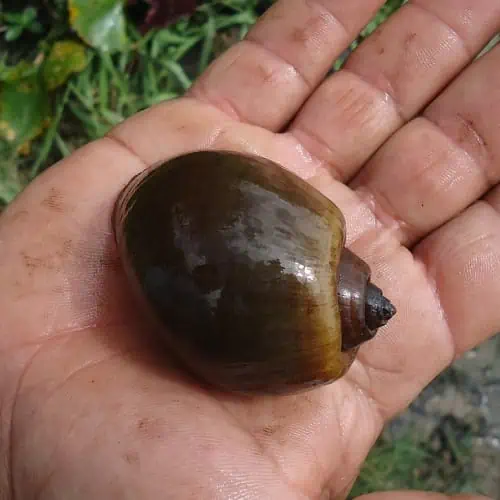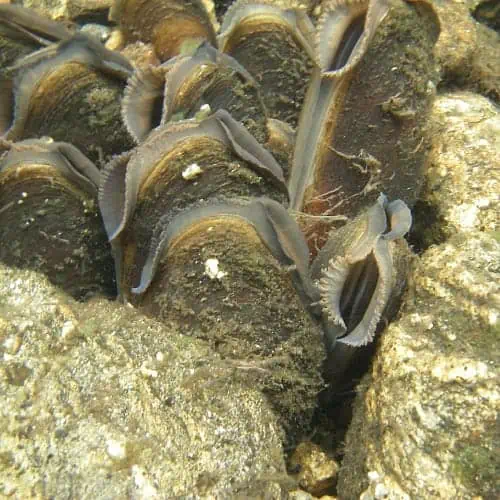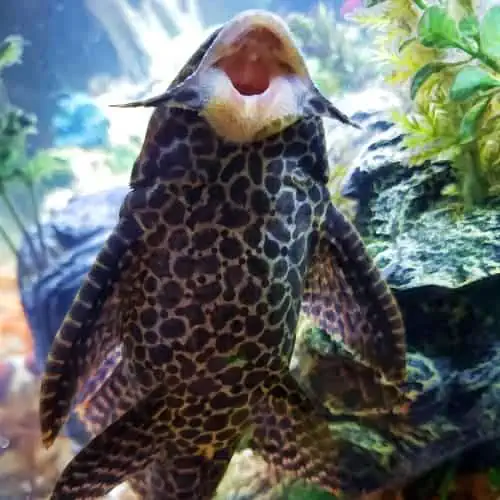Decomposers That Feed of of Algae
List of Decomposers in a Freshwater Pond Ecosystem [Updated]

Freshwater ponds are complex ecosystems that rely on the balance between their biotic and abiotic components. Those in the wild are self-sustaining bodies of water, which means they can produce their own needs, manage waste, and thrive without human interference. One of their most important components is comprised of tiny animals and microbes that assimilate organic matter. In food webs, this group is often referred to as decomposers or detritivores.
Decomposers break down all sorts of organic waste, ranging from the smallest of leaves to the largest of decaying fish. They tend to play multiple roles in the food chain as they are both primary consumers and a major source of nutrients for larger animals. Their waste consumption recycles all the spent nutrients and transforms them into consumable materials. Without them, a freshwater pond could quickly become a pool of toxic waste, unable to cycle nutrients in a manner that sustains producers (plants) and consumers (larger animals).
Typically small, decomposers are seldom picky eaters. They can favor and colonize almost anything that's organic. They can occupy a range of microhabitats as well, from the dark gaps in between pond sediments to the sunlit surfaces on the pond's floor or walls. Even ornamental ponds can be naturalized to have their own fair share of these organisms to help maintain water quality. Listed below are some general types of decomposers and their important attributes.
Several types of worms can live in a freshwater pond. Many of these are closely related to terrestrial species but have adaptations that allow them to live a fully submerged existence. Others have ancestors that originated from marine environments. Some aren't true worms in that they are aquatic larval forms that must undergo metamorphosis as they mature. Common aquatic worms include:
- Nematodes: free-living roundworms that reside in benthic substrates
- Flatworms: Turbellaria, free-living and usually found on rock surfaces in slow-moving water
- Horsehair worms: may navigate across terrestrial substrates after exiting a pond and may be found in puddles and small streams; larval stages may require an arthropod host
- Tubifex worms: annelids that are often fed to freshwater aquarium fish
- Oligochaetes: freshwater earthworms with bristles
- Leeches: a type of segmented annelid with oral suckers for attaching onto hosts and for feeding
These aquatic worms graze on primary producers, bacterial biofilm, and plant matter. Some species can develop within the bodies of decaying animals, aiding in the rapid breakdown of their tissues from inside out. These generally reproduce quickly and have relatively short lifespans. Many also function as bioturbators, increasing oxygen and water flow in bottom substrates.
Aquatic worms are usually the favored prey choices of benthophagous consumers. They tend to be highly palatable sources of protein. Note that many of these can be carriers of pathogens as well. Avoid collecting worms from wild freshwater environments with the intention of diversifying your own pond. Allow them to populate your pond on their own by naturalizing the pond floor.
2) Freshwater gastropods

Have you ever gone for a casual swim in a pond or lake, only to find that something sticky has latched onto your skin? If it wasn't a leech, it was likely a freshwater gastropod. Snails and slugs require moist environments to stay mobile, so freshwater ponds are some of their favorite haunts.
Soft-bodied gastropods can be wholly aquatic or capable of traveling through moist land. They are found all over the world and can occur in aquatic environments with a wide variety of conditions. Some are adapted to fast-moving bodies of water, whereas others are restricted to calm streams and still pools.
- Ramshorn snails (Planorbidae): amphibious snails with disk-like shells
- Apple snails (Ampullariidae): amphibious snails that are equipped with both gills and lungs; largest freshwater snails
- Freshwater nerites: primordial, gill-breathing snails that can feed on diatoms
- Mud snails: herbivorous snails that can bear live young
- Bithynia: detritus-feeding, gill-breathing snails with an oval or conical shell
A few types are marketed by the aquarium industry as they can aid in keeping a tank clean. These include apple snails, with the most commonly sold species being Pomacea diffusa and ramshorn snails. These are highly adaptable gastropods with a tendency to grow quickly. They also feed on rejected fish food and tank or pond debris.
3) Bivalves

Though most bivalves reside in saltwater environments, there are a few noteworthy species that thrive best in freshwater or brackish pond and lake systems. These can range anywhere in size from 0.3 – 20 cm, and they usually favor relatively calm waters. Their lifespans range from as little as a few years to several centuries!
Bivalves provide a wealth of ecosystem services wherever they are found, largely due to their filter-feeding behavior. Excess nutrients, organic matter, and even heavy metals are sequestered in their tissues. As a result, many species are used as important bioindicators and are the subjects of spatial and temporal studies on water quality. Moreover, they serve as rich food sources for many larger fish species.
Though widely distributed across all continents except for Antarctica, many species are now considered endangered. This is due, in part, to invasive species and the destructive impacts of anthropogenic activities. Some are also harvested or intentionally farmed due to demand for their tissues or byproducts as food, jewelry, and ornaments. Notable types of freshwater bivalves are listed below.
- Swan mussel (Anodonta cygnea): the largest of freshwater mussels, found in rivers and streams with muddy bottoms
- Pea clams or fingernail clams (Pisidium): very small, free-living bivalves that may occur in large quantities and alter their environment
- Freshwater pearl mussels: farmed at large scales as they are the sources of freshwater pearls, but some types are now endangered in the wild
- Zebra mussel: known for being invasive species in many parts of the world
4) Insect larvae

Apart from aquatic insects, a great number of terrestrial species have fully aquatic nymphs or larvae. These usually arise from eggs that are laid directly in water or on overhanging foliage. Their larval stage tends to last much longer than any other phase of their life cycle. As larvae, the insects load up on nutrients that are essential for them to undergo metamorphosis. Some of them have sharp pincers to aid in the consumption of tough food types, such as the muscles of decaying fish.
In fresh water, insect larvae may appear worm-like and fleshy. They lack the appendages of their adult counterparts, making them look like wholly different animals. Some species may pupate in water, others exit the pond and search for a suitable area in soil or under the protection of foliage and rocks. Their adult counterparts may occasionally return to the water, but many take flight just to breed on dry land.
One of the most famous examples of terrestrial insects with aquatic larvae is the mosquito. These are notorious for laying their eggs wherever there is stagnant water and mild temperatures. With their fan-like mouths, they feed on microbes and particles of organic matter. Their larval stage lasts for up to two weeks, after which they develop into inactive pupa in water. Both mosquito larvae and pupae are food sources for many aquatic animals. Other types of insect larvae include:
- Midge fly larvae: red and wormlike, segmented larvae that wriggle in water
- Dragonfly larvae: breathe through their rectum (which is where their gills are located) and have wing buds behind the thorax
- Mayfly larvae: can live for years in water and may feed on detritus or plant material, depending on the features of their environment
- Hoverfly larvae: also called the rat-tailed maggot, have a posterior siphon that permits air-breathing while the larva is submerged
- Alderfly larvae: predatory larvae sharp pincers
5) Aquatic insects

Some adult insects have evolved to maintain a semi-aquatic life cycle, with adults that can breed and feed in water. They usually have clever adaptations that allow them to breathe while submerged. These include siphons that must reach the water's surface, hemolymph for oxygen storage in the blood, a plastron for oxygen extraction, dense setae for collecting air bubbles, and thin integumentary tissues for rapid diffusion. Their ability to hunt and hide in water may serve as an evolutionary advantage over strictly terrestrial insects.
Highly diverse, these insects play important roles in freshwater systems. As some of them can feed on land as well, they can introduce land-based nutrients into water. They are a vital source of food for larger fish that require protein-rich prey. Aquatic insects are quite abundant in well-balanced ecosystems. Some species feed on algae and plant matter, whereas others feed on smaller insects, larvae, and zooplankton. Keep an eye out for these beneficial types:
- Water striders (Gerridae): Usually found on the water's surface, but they can dive into the water to feed; underwater breathing is facilitated by air that is trapped on their fine hairs
- Water boatmen (Corixidae): Non-predatory, they feed on algae and aquatic plants
- Backswimmers (Notonectidae): Closely related to Corixidae, distinguished by their inverted mode of swimming
- Diving beetles (Dystiscidae): A diverse group of beetles that are often preyed on by fish; some species have carnivorous larvae (known as water tigers)
- Riffle beetles (Elmidae): Hard-bodied, aquatic beetles that favor microhabitats in the riffle zones of streams
6) Crustaceans

Freshwater crustaceans are fascinating creatures that can help shape their native environments. These invertebrates are quite diverse; some are microscopic whereas others are lobster-sized and are considered an absolute delicacy. They tend to be associated with benthic habitats, where they feed on a wide assortment of prey types and decomposing materials.
This group includes freshwater decapods (crabs, shrimp, crayfish), copepods, isopods, amphipods, and more. The latter types are much smaller and may be considered types of zooplankton. These are generally scavengers, feeding on the decaying remains of other freshwater animals. They may also be herbivores or omnivores, with some opting to feed on decaying plant material.
Many freshwater crustaceans eventually become prey to larger animals. Those with hard-bodied shells have predators that are equipped with the means to break and digest them without harm. They have varied means of locomotion and prey capture, and are thus known for being exemplary survivalists. Even highly polluted freshwater systems may have thriving crustacean populations. Here are some desirable species to have in your own pond.
- Water slaters: isopods that feed on debris, algae, and detritus on the pond bottom
- Daphnia: a type of water flea and a favorite treat for small fish
- Cyclops: may be planktonic or benthic, highly important members of ecologically balanced freshwater food webs
- Caridina and Neocaridina: filter-feeding, omnivorous shrimp that are popular in the aquarium industry
7) Opportunistic fish

Though they primarily occupy the niche of secondary consumers, some types of fish are quite effective as decomposers as well. These tend to be opportunistic scavengers that will readily feed on decaying animals. Many are popular to have in ornamental ponds and aquariums as they can aid in keeping surfaces clean and reducing leftover feeds. These include the following types:
- Plecos: often known as janitor fish, they are known for being opportunists that eat almost anything they come across
- Catfish: prefer high-protein food types, but will generally consume almost all types of organic matter
- Loaches: may consume algae, small crustaceans, and insects
Note that some of these can only aid in the breakdown of larger pieces of organic matter. Others may appear to consume sediments, but they may expel these once they have consumed the biofilm around them. They require the presence of many smaller types of decomposers, especially as they produce considerable amounts of their own waste.
Avoid introducing these fish or collecting them from wild areas as they may spread diseases and parasites. Keep in mind that those found in pet stores may have been reared using artificial selection, so they may be dissimilar to their wild counterparts.
8) Amphibian larvae

The larvae of frogs, toads, newts, and salamanders may function as decomposers as they consume particulate organic matter during their first few days to weeks of life. These particles may come in the form of dead algae, plants, and small pieces of decaying meat. They may not play as active a role in waste decomposition as other decomposers, especially as they don't necessarily target waste as a primary product.
After a few weeks of development, the diet of amphibian larvae can change in favor of more protein-rich food sources. As their oral tissues enlarge, they may shift to consuming live prey items instead of particulate matter. This is yet another example of how decomposers can eventually take on the role of primary consumers as they mature.
9) Bacteria

Primary decomposers in freshwater ecosystems, bacteria are microbes that reside on virtually all organic and inorganic surfaces in a pond. Though extremely small and invisible to the naked eye (unless they are present in colonies), they are some of the most important elements in every ecosystem. Their densities are highest in sites with significant rates of waste accumulation, as they can quickly reproduce when nutrients are readily available.
Some types of bacteria are incredibly beneficial to have in ponds because they play a lead role in the nitrogen cycle. They can convert ammonia, nitrates, and nitrites into non-harmful byproducts, freeing up important base elements in the process. As they assimilate nitrogenous and carbon-rich compounds, they hasten the breakdown of sludge, decaying leaves and animals, dead algae, fish waste, and so much more.
A group of bacteria that acts as both primary producers and decomposers are cyanobacteria. As these can form vividly-colored mats and biofilms, they are often referred to as blue-green algae. These may occur in haphazard amounts as a result of nutrient loading, causing toxic algal blooms that may suffocate pond life. A mass die-off of fish or excess erosion, for example, may incite a bloom that will generate its own waste materials. This goes to show that, though bacteria are themselves important for recycling nutrients, the right strains must occur in balanced concentrations to be beneficial.
10) Fungi

Fungi may be present as molds, yeast, or mildew in ponds. To expand their colonies, they likewise assimilate freed-up nutrients that may occur in the water column or on surfaces. They act as heterotrophs, which consume organic materials to obtain energy.
Expanding in size via mycelial growth and the development of hyphae, aquatic fungi are intimately associated with the surfaces they colonize. However, they have a complex life cycle that allows their spores to be dispersed over considerable distances.
Most types of aquatic fungi depend on decaying particulate organic matter for their nutrient requirements. This is especially rich in leaf litter sourced from plants of a terrestrial origin (such as from riparian zones) and in dead aquatic plant material. It is estimated that a whopping 3,000 species of fungi naturally occur in freshwater habitats. Many of these form symbiotic relationships with animals and plants. Though often overlooked, this is one group of microbes that is undoubtedly important for the maintenance of a balanced ecosystem.
Source: https://pondinformer.com/pond-ecosystem-decomposers/
0 Response to "Decomposers That Feed of of Algae"
Post a Comment